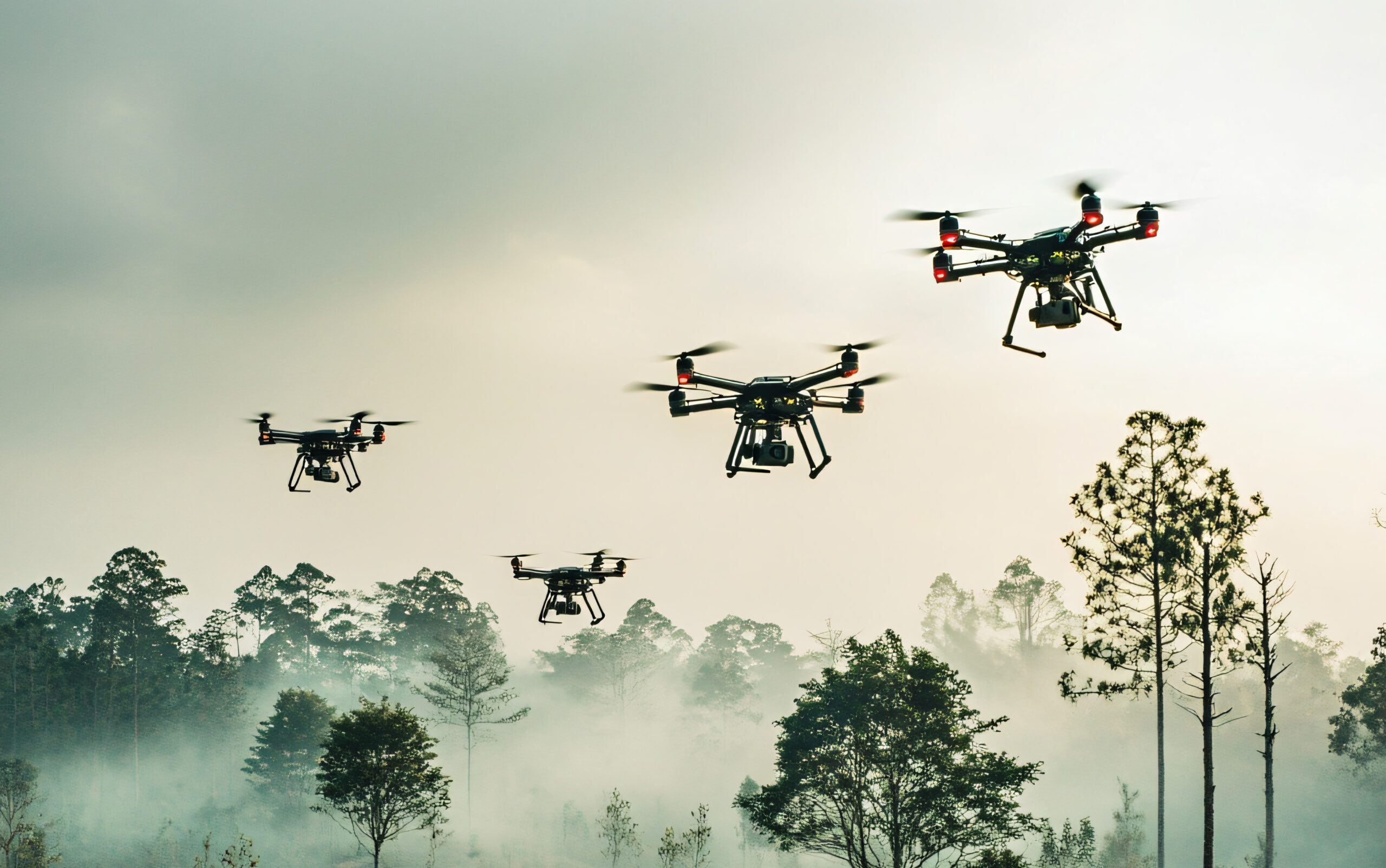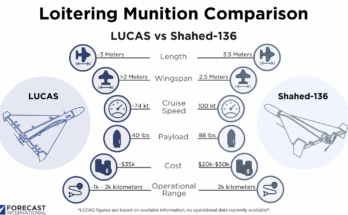
In January 2025, the Swedish Armed Forces unveiled a new drone-swarming program, developed by defense giant Saab. This cutting-edge software empowers soldiers to control up to 100 uncrewed aircraft systems (UAS) simultaneously. Testing of the software is scheduled for March 2025 during the Arctic Strike Exercise and is expected to demonstrate the ability of the drones to adapt to reconnaissance, defense, and payload delivery tasks in complex environments. Conflicts in Ukraine, Russia, and the Middle East have already demonstrated the critical role of coordinated drones in modern warfare, highlighting their decisive impact on the battlefield. As NATO’s newest member, Sweden’s investment in UAS and drone swarm innovations marks a significant step forward in shaping the “Drone Wars” era, heralding a transformative chapter in the evolution of military strategy.
Unraveling the Mystery of Drone Swarms
“Drone swarms”, as defined by the U.S. Government Accountability Office (GAO), consist of coordinated systems of at least three and potentially thousands of drones that can perform missions autonomously with minimal human oversight. These swarms leverage swarm intelligence, mirroring biological patterns seen in groups of ants, bees, or birds, where decentralized rules create complex collective behavior. Modern swarms integrate artificial intelligence (AI) and machine learning (ML) to navigate obstacles like GPS jamming, radio signal interference, and adverse environmental conditions, maintaining synchronized operations. Command and control methods vary from preprogrammed flight paths and centralized ground-based oversight to distributed control systems allowing drones to communicate dynamically in real time.
The Military Advantage: Why Swarms Matter
Drone swarms have fundamentally shifted the cost-benefit analysis in military strategy. Traditional deterrents, such as HIMARS, Tomahawks, and SM-6 missiles, come with staggering price tags running into millions per unit. In stark contrast, swarms of expendable drones offer an affordable, versatile, and resilient alternative. By enabling synchronized operations across air, land, and sea, swarms provide unparalleled situational awareness and agility in real-time. They can overwhelm defenses, penetrate adversaries’ networks, and execute missions with a combination of stealth and brute force, all while maintaining a high tolerance for attrition.
Global Developments and Key Milestones
1. United States
- The Pentagon’s Replicator program aims to deploy thousands of inexpensive, autonomous drones by August 2025. With $500 million allocated for Fiscal Year 2024 and additional requests for FY 2025, efforts focus on Autonomous Collaborative Teaming (ACT) and Opportunistic Resilient Network Topology (ORIENT) to ensure effective drone coordination and communication.
- The Perdix System, operational since 2016 and developed by MIT Lincoln Laboratory, has undergone rigorous testing, including integration with F/A-18 fighter jets. Over 670 Perdix drones have been produced, showcasing significant advancements in swarm capabilities.
2. China
- The Jiu Tian “mothership” drone, was revealed at the Zhuhai Airshow in November 2024. This 10-ton UAV, equipped with a modular payload bay, can deploy smaller swarms at speeds of up to 560 mph (900 kph) with a 1,200-mile (2,000 km) range. It is larger than the U.S. MQ-9 Reaper which weighs in at about 6 tons.
3. Europe
- Germany: The KITU 2 program, launched by the Bundeswehr in July 2023, integrates AI-driven swarm behaviors. Tests in August 2023 involved multi-UAV coordination under GPS-deprived conditions, linked to the Fortion Joint C2 system for single-operator oversight.
- Additionally, in September 2024, German drone producer, Quantum Systems, in collaboration with the German Armed Forces tested AI-controlled UAS at the Airbus Drone Centre in Bavaria. The tests integrated Quantum Systems’ Vector and Scorpion UAS with two Airbus drones, merging real-time reconnaissance data into an Airbus battle management system.
- United Kingdom: In July 2023, the UK Defence Science and Technology Laboratory (Dstl) awarded SeeByte and Blue Bear a contract under the Progeny Maritime Research Framework to develop a secure architecture for Mixed Multi-Domain Swarms (MMDS) of Robotic Autonomous Systems (RAS). The initial 12-month phase will focus on designing an architecture that enables autonomous collaboration between air, land, and maritime vehicles. This builds on previous work, such as May 2024’s AUKUS Pillar 2 trials involving autonomous systems like Blue Bear Ghost UAVs, Viking ground vehicles, and Challenger 2 tanks, which demonstrated coordinated swarm capabilities in combat scenarios.
- The Netherlands: Project Steadfast, funded in February 2024 with €2.7 million by the Dutch Research Council, explores swarm technology for security applications, focusing on integration across multiple operational environments.
4. Ukraine and Turkiye
- Although not as advanced in AI integration, Ukraine has employed First-Person View FPV drones, FlyEye and Granat-2 UAVs in swarms successfully, however individual drones remained under pilot control rendering these instances not true “swarm technology”.
- Turkiye began developing swarming technology for its Kargu-2 drone in 2020. These drones, produced by STM, are small 15-pound multicopters designed for precision strikes. Unlike the U.S. Switchblade which is designed for single use, the Kargu-2 is designed to return to the operator if no target is found. Kargu has the capability to operate in a swarm of up to 20 drones.
The Defensive Dilemma
Countering swarm attacks poses a significant challenge for traditional defensive systems, which struggle to match the resilience, redundancy, and adaptability of these next-gen threats.
One of the key challenges when countering drone swarms is the cost disparity. Drones such as the Lancet can be relatively inexpensive, with only minimal cost overhead for mass deployment. On the other hand, defensive systems like surface-to-air missiles (SAMs) or high-end air defense systems can be prohibitively expensive. For example, a single IRIS-T short-range SAM, supplied to Ukraine, can cost upwards of $450,000—compared to a drone like the Shahed-136, which costs around $20,000. The significant price gap makes it impractical for defenders to use expensive missiles against a barrage of low-cost drones, quickly depleting stockpiles and draining defense resources.
Several technologies and countermeasures are proposed to balance this issue, including electronic warfare (jamming), high-energy lasers, and microwave systems such as those tested by the U.S. Marine Corps’ L-MADIS system. While promising, these systems are not yet fully operational on a large scale.
The rise of drone swarm technology is more than a fleeting trend; it represents a seismic shift in global military strategy. Whether for reconnaissance, offense, or hybrid missions, drone swarms are cementing their place at the forefront of the future of warfare.
Aja Melville is an accomplished editor and analyst with expertise in open-source intelligence (OSINT) and database management. As the Weapons Editor and Analyst at Military Periscope, Aja has applied her analytical skills and in-depth knowledge in military affairs and global defense sector advancements, particularly focusing on China and the Asia-Pacific region.
Aja's commitment to international relations and Asia-Pacific focus is highlighted by her educational background. She holds a Bachelor of Arts in International Relations and Chinese Language from Bard College, complemented by a Certificate of Advanced International Studies from the Bard Globalization and International Affairs Program. Aja further expanded her linguistic skills with a Certificate of Intensive Language Studies in Chinese (Mandarin) from Qingdao University.




